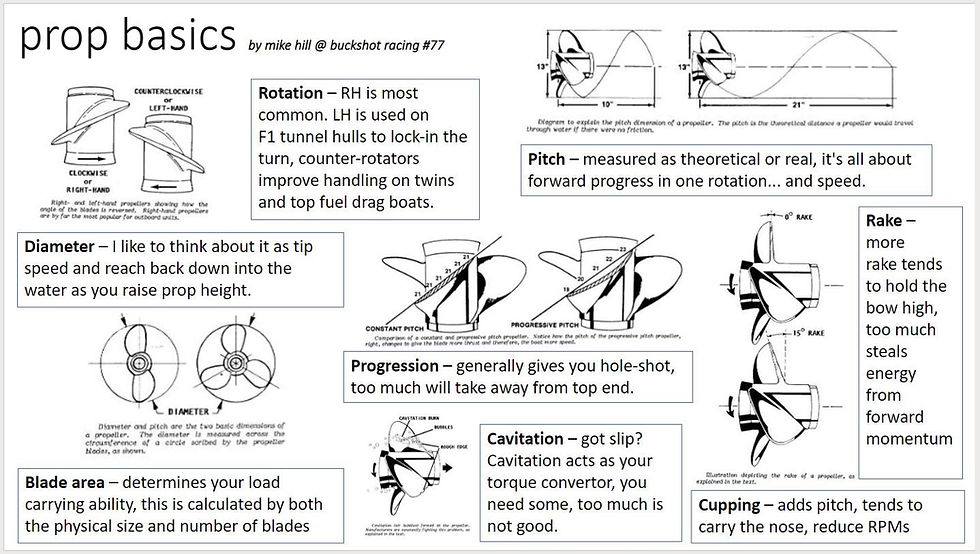Remove Hooks & Rockers for More Speed & Handling
- Mike Hill
.JPG/v1/fill/w_320,h_320/file.jpg)
- Sep 28, 2024
- 4 min read
Updated: Dec 20, 2024

Straightening the bottom (running surface) of a high-performance single or twin-engine outboard boat is essential for maximizing speed, handling, and overall performance on the water.
Imperfections like hooks (concave areas) and rockers (convex areas) on the bottom hull can disrupt water flow, change lift, create drag, and adversely affect stability and control.
This technical guide will walk you through the process of identifying, straightening, and blueprinting (fine-tuning) the bottom of your boat to eliminate these performance-robbing flaws.
Understanding Hooks and Rockers
Hook: A hook is a concave area along the running surface of the boat hull. It often develops due to age, impacts, improper storage, or even OEM manufacturing flaws when the hull cures in the mold. Hooks create suction, increasing drag and causing the bow to run lower, reducing speed and hampering acceleration.
Rocker: A rocker is a convex area on the hull, often near the transom. Rockers can cause the boat to porpoise (bounce), lead to a blowover or reduce lift, and negatively impact handling at high speeds.
Tools and Materials Needed
Straightedges (4-6 feet long)
Spirit level or digital level
Sanding blocks or longboard sanders
80-600 grit sandpaper
Fairing compound (marine-grade)
Fiberglass resin and cloth (if needed)
Body filler (optional)
Mixing cups and stir sticks
Masking tape
Personal protective equipment (gloves, respirator, goggles)
Step 1: Assess the Bottom Condition
Dry Dock the Boat: Safely secure the boat on a trailer or lift, ensuring the bottom is accessible. Ensure it's level on both the longitudinal and transverse axes.
Inspect the Bottom: Using a straightedge, inspect the entire length of the running surface focusing on the last 36 inches of the stern area. Place the straightedge along the centerline and at various points outward toward the chines. Check for any slight air and light gaps indicating hooks or rockers.
Mark Problem Areas: Use masking tape to outline the affected areas. Mark hooks and rockers clearly to visualize the work scope.
Step 2: Prepare the Surface
Sand the Area: Start by sanding the marked areas using the right 80-220 grit sandpaper on a longboard sander based on the amount of material you will need to remove. This roughens the surface, ensuring the fairing compound adheres properly. Sand beyond the immediate problem area to allow for smooth transitions.
Clean the Hull: Wipe down the sanded areas with acetone or a suitable marine cleaner to remove dust, oil, and debris. Ensure the surface is clean and dry before applying the fairing compound.
Step 3: Fairing the Hull
Mix Fairing Compound: Mix the marine-grade fairing compound according to the manufacturer’s instructions. Fairing compounds are designed to adhere well, sand easily, and resist water intrusion.
Apply the Compound: Using a spreader, apply the compound to the sanded areas, filling in the hooks and leveling rockers. Apply in thin, even coats, building up as needed. Focus on creating a flat, continuous surface with smooth transitions and sharper edges.
Level with a Straightedge: Use your straightedge frequently to check your progress. Adjust and apply more compound as necessary until the surface is flush.
Allow to Cure: Let the fairing compound fully cure according to the manufacturer’s guidelines. This typically takes 24 to 48 hours, depending on the product and ambient conditions.
Step 4: Sand and Refine
Sand the Cured Compound: Once cured, sand the faired areas using progressively finer grits (starting with 100 grit and finishing with 220 grit) to achieve a smooth, flat surface. Keep checking with the straightedge to ensure the area is perfectly straight.
Blend Edges: Feather the edges of the faired area into the surrounding hull to avoid sharp transitions that could cause drag.
Inspect for High or Low Spots: Use the straightedge and level to inspect for any remaining high or low spots. Reapply the fairing compound if needed and repeat sanding until the surface is perfect.
Step 5: Reinforce if Necessary
Fiberglass Reinforcement: If structural repairs were made or significant material was removed, consider reinforcing the area with fiberglass cloth and resin. This adds strength and ensures the hull can withstand high-speed forces.
Apply Resin: Lay fiberglass cloth over the affected area, apply resin, and smooth it out with a squeegee. Allow curing, then sand smooth.
Step 6: Final Finishing
Apply a Sealer or Barrier Coat: Once the surface is fully refined, apply a marine-grade sealer or barrier coat to protect the hull from water intrusion and ensure a smooth, drag-free surface.
Finish with Bottom Paint: If necessary, finish with high-performance bottom paint suitable for racing. This final coat will enhance hydrodynamics and provide additional protection.
Step 7: Test the Boat
Water Trial: Take the boat out for a test run to assess the improvements in speed and handling. Note any changes in performance and make additional adjustments if needed.
Fine-Tune Trim: Adjust engine height and trim settings to fully exploit the newly straightened hull for peak performance.
Conclusion
Straightening the bottom of your high-performance single or twin-engine outboard engine boat is a meticulous process that can significantly enhance speed, handling, and overall performance.
By carefully identifying and removing hooks and rockers, you reduce drag, improve stability, and get the most out of your setup.
Regular maintenance and hull inspections will help keep your boat performing at its best, giving you a competitive edge on the water.





Comments